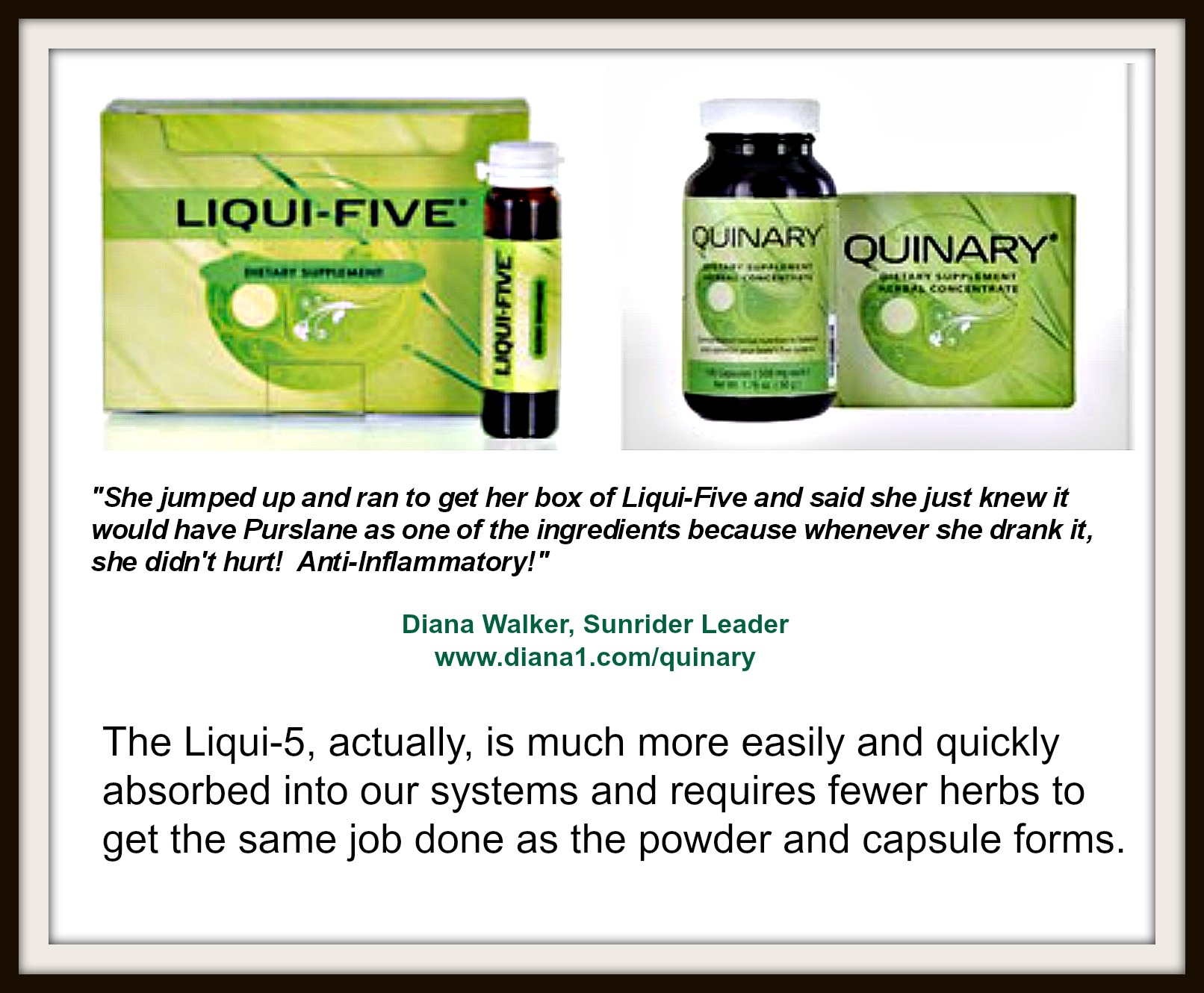You know, it’s funny I still get excited when I am reminded of how wonderful these products are. And what’s really bizarre is that I still need reminders. Here’s what I mean:
I was watching Dr. Oz on Oprah and he was showing a nutritious food called Purslane. He was going on about how he was born in Turkey and how they eat it there and how great it is for us. Oprah said she’d never seen it before. Dr. Oz said it is not easy to get. Well, I was thrilled! Want to know why?
Many years ago a consumer called me. She was all excited because she’d been watching Dr. Andrew Weil, the doctor who worked at U of A and who’s been on PBS and speaks about natural healing. He, too, was talking about purslane and said that it is anti-inflammatory.
She jumped up and ran to get her box of LIQUI-FIVE and said she just knew it would have Purslane as one of the ingredients because whenever she drank it, she didn’t hurt! Anti-inflammatory!!! She was thrilled to see that it was the second ingredient!!! Well, if that isn’t the most perfect way to get confirmation of how good these products are, I don’t know what is!
So, after watching Dr. Oz, I was reminded, again, of how wonderful this formula is and ordered some. Though Purslane, for most, is hard to get, it is easy for us to get in this Chinese herbal formula.

Have you ever noticed that powder and capsule Quinary contain 50 herbs while Liqui-5 has only 29? How can we say that all forms of Quinary nourish the body in the same way when there seems to be such a great discrepancy?
Once again East teaches West that more is not necessarily better. At the Orlando Regional, Don Caster paraphrased Dr. Chen’s metaphor, “cargo, vehicle, and driver”.
In a nutshell, this means that the “cargo” is always the same (system-specific foods for each of the five organ systems).
The “vehicle” being a liquid rather than powder is clearly different, which requires a different “driver” (to get the nutrients into our systems). You wouldn’t want a bus driver piloting your plane, would you?
The herbs are much more easily and quickly absorbed into our systems and requires fewer herbs to get the same job done as the powder and capsule forms.
And since we’re on the topic of Quinary, most of us know that the herbs, highly digestible and quickly assimilable, are an “acquired taste”. That’s doublespeak for “most Americans think it tastes horrible”. Ha! However, upon further study, one discovers the Chinese teaching that the five flavors (sweet, sour, salty, bitter, and pungent), just like the five elements, all have great value in helping the body achieve balance.
It is well known that most Americans choose to eat only sweet, sour, and salty, while avoiding the bitter and pungent. Could these out-of-balance food choices be yet another contributing factor to many Americans’ out-of-balance lives?
Try the Liqui-5. Listen to your body, and learn what it might tell you about how it experiences this in comparison to other forms of Quinary. The body loves variety and our hunch is that even if your tongue says YUCK, your body will say YUM!
In fact, Geneva Peterson tells the story of her two year old grandson waking up in the night, crying for his dad to bring him WICKIE FYE (Liqui-5). Of course the concerned father asked the little boy whether he was sick. The child replied, “No, I just want some Wickie Fye and a sip of miwk”. When the youngster had drunk both, he peacefully went back to sleep. Obviously, the little guy had already acquired the taste!
One last note regarding Five Flavors
Trish Powers and Renée Emrick were introducing Kathy Bick to these natural foods. When they got to the part about Liqui-5 and the five-flavor theory, Kathy became very excited. You see, Kathy works for Earthwatch, which, some of you may know, sponsors medical teams who go into Third World countries to volunteer assistance to those who need it most. In her travels, Kathy had noticed that in many primitive cultures, some rites of passage are marked by the placing on the tongue of all five flavors — sweet, sour, salty, bitter, and pungent!
Quinary Ingredients:
Chinese White Flower, Scutellaria Herb, Dandelion Root, Gou Teng, Licorice Root, Mint Leaf, Paris Herb, Mandarin Orange Peel, Coix Lacryma-jobi Seed, Fennel Seed, Cinnamon Bark, Poria (Mushroom Powder), Chinese Yam, Ginger Root, Golden Bell Fruit, Sophora Flower, Hawthorn Fruit, Barrenwort Herb, Chuhm Xiong Root, Mongoliavine Root, Fang Feng Root, Panax Ginseng Root, Honeysuckle Flower (Silver Flower), Yeuan Wu Root, Chrysanthemum Flower, Dispacacus Japonicus Root, Angelica Root, Alpina Ginger Root, Angelica Centis Root, Leek Seed, Balloon Flower Root, Bamboo Leaf, Dwarf Lilly Turf Root, Papermulberry Seed, Senega Root, Imperate Root, Cornel Fruit, Forty-knot Root, Burdock Fruit, Cnidium Seed, Reed Root, Broomrape Herb, Chinese CatNip, Asias Herb, Bai-Zhu Root, Lycium Fruit, Eucommia Bark, Morinda Root.
*These statements have not been evaluated by the Food and Drug Administration. This product is not intended to diagnose, treat, cure or prevent any disease.
Diana Walker, Nutrition Leader
https://www.diana2.com

